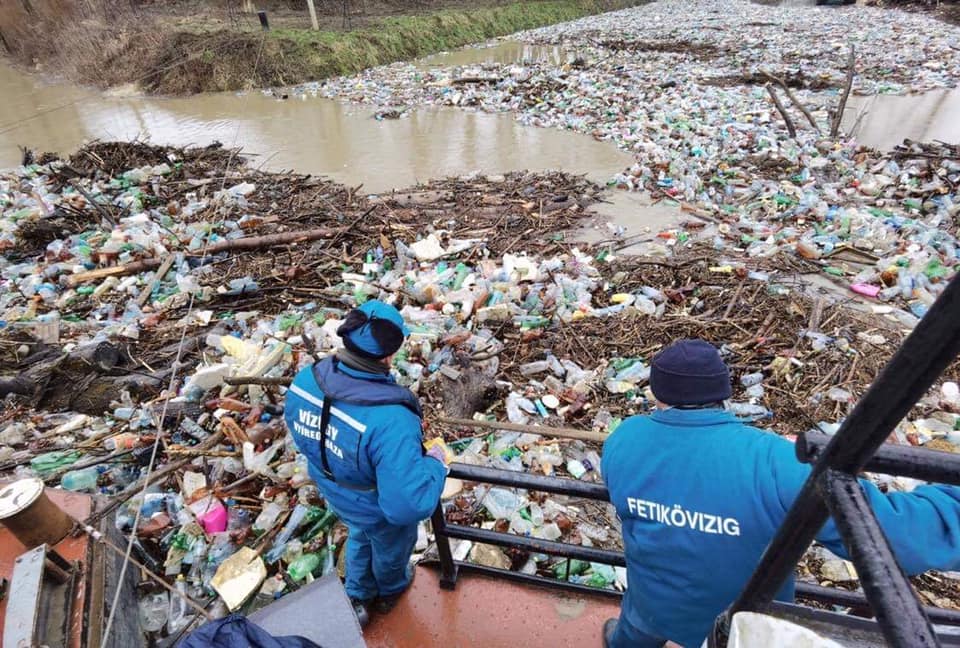Tisza river has been carrying Ukraine s waste to Hungary for 15 years
When Tisza River floods, it picks up piles of garbage from the (mostly illegal) landfills along its banks in Ukraine, transporting huge amounts of waste to Hungary. Ukrainian authorities have been unable to prevent this for over 15 years.
Due to high precipitation and melting snow, the Tisza River is flooding along its Ukrainian section. Just like in the past 15 years or more, the river has been (and still is) carrying shocking amounts of waste to Hungary, where the cleanup is a big problem for the authorities.

The situation this year is exacerbated by snow barriers that are blocking access to the riverbank, making it impossible – according to Ukrainian press reports – to clean up the (illegal) landfills, where the river picks up and washes away all the litter and waste.
The fact that Ukraine s garbage has become a problem of international dimensions is mainly due to the country s inconsistent and neglectful waste management policies, something local authorities are now also treating as a fact.
Waste management (or its lack thereof) in Lviv, a city boasting a population of nearly 750 thousand in western Ukraine, has long been an issue. The city does not have its own waste disposal site, so it transports domestic waste to sites across Ukraine, with tonnes of waste and garbage ending up in illegal landfills or green areas. Lviv s city administration is admittedly aware of the problem.
Reports about grossly negligent waste management practices in Rakhiv, a town in the Transcarpathian region, have also made headline news. Rakhiv has no official waste disposal site either, so the embankment of the Tisza River is dotted with swathes of spontaneously accumulating rubbish.
Rakhiv district s only operational waste disposal site is overwhelmed, stretching beyond its designated boundaries and reaching the Tisza River. Nikolai Kokis-Melnyk, deputy head of the Rakhiv district council, told the local press last March that Hungarian authorities and the consulate had contacted Rakhiv s town hall regarding their waste management concerns, but the town s mayor at the time decided to ignore these inquiries. Instead, there were times when – ahead of the expected flood-waves – the mayor had Rakhiv s public utility company dump rubbish into the Tisza with machinery, Mr Kokis-Melnyk said. (Rakhiv is at the confluence of the smaller White and Black Tisza rivers)
Nikolai Kokis-Melnyk said he had contacted the authorities about Rakhiv district s waste disposal problem, but „everyone just shrugged their shoulders.” He recalled that the district council had earmarked 300 thousand hryvnias (nearly 9 thousand euros) to erect a concrete wall to protect the Tisza River from the waste „spilling over” from the above-mentioned waste disposal sites. Instead of the wall, which was never built, authorities green-lighted the construction of a gravel embankment, which provided no protection at all, as the rising water simply picked up and washed away the gravelstones, along with the waste. At other times, when the precipitation is low and Tisza s water level is not high enough, „swathes of floating rubbish piles” form in Rakhiv district and drift towards Hungary, according to the article.
Tisza River – called „blonde Tisza” by many Hungarians because of its colour – hardly deserves its nickname in Ukraine, where it s most polluted river. Hungary s water management authority is struggling to halt the piles of waste at several points, inlcuding the town of Vasarosnameny, near the border. According to Ukrainian press reports, Hungarians use excavators to remove Ukraine s waste from their river, with at least 60 tonnes of plastic and other waste lifted during May last year alone. „Greetings from Ukraine!”, wrote a Ukrainian portal, commenting on Hungarians efforts.
Alexander Chistyakov, the director of Ukraine s National Ecological Council, confirmed during last spring s flood-waves that polluting the river Tisza with garbage had been a problem for at least 15 years, as Ukrainians considered its embankment nothing but an an illegal landfill. He said Ukraine had around 35 thousand unlicensed landfills „in operation” in the spring of 2020, covering a total area of more than 14 thousand square kilometres – roughly the area of the Transcarpathian region – all drowning in waste.
The expert also warned that the bottom of the river was just as polluted, meaning that the garbage sent to Hungary was only a part of the problem. Plastic in water breaks down into carcinogenic micro particles, after which it becomes food for fish. And then the people of Ukraine, including those in the Transcarpathian region, eat the fish and drink the water, thereby consuming poison, Chistyakov said.
Ukraine s state environmental inspectorate has recently announced that it will cooperate in compiling an interactive map of the „protection zones” along the Tisza. It is planned to include high-risk areas such as landfills and industrial waste disposal sites. The inspectorate s official website writes that the map will help authorities in carrying out thorough checks.
Igor Sinkaryuk, deputy chairman of the Transcarpathian Regional State Administration, announced recently that they are cooperating with the Hungarian, Romanian and Slovak authorities in the framework of a cross-border programme, relying heavily on the experience of those authorities. The plan is to create a special pontoon dam on the Tisza, which would filter out garbage on the Ukrainian section of the river, so that none or only a small fraction of it would reach Hungary.
In response to a question regarding the topic in parliament, Hungarian Foreign Minister Peter Szijjarto said Hungary makes sure that its rivers exiting the country are not polluted. However, in Ukraine and Romania certain regulatory shortcomings and non-compliance with the rules appear to prevent this. Hungary has contacted both countries at a ministerial level, offering its assistance.
FM Szijjarto s speech in parliament was also prompted by the fact the heavy metal pollution carried by te Tisza from Romania has reached Hungary int he past few days.
Tags:

